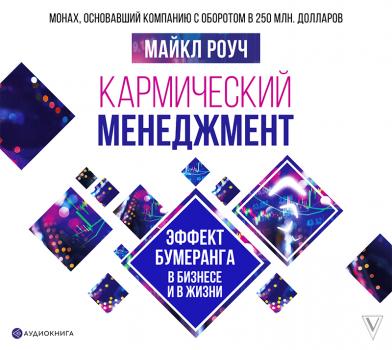MREADZ.COM - много разных книг на любой вкус
Скачивание или чтение онлайн электронных книг.Кармический менеджмент: эффект бумеранга в бизнесе и в жизни
Продолжение культового бестселлера «Алмазный Огранщик», набор принципов, которые сделают управление компанией успешной, выведут и укрепят ее позиции на рынке, помогут прыгнуть выше поставленных ранее задач. Есть люди, истории которых меняют наше представления о возможностях человека. Майкл Роуч провел более 20 лет в тибетском монастыре, став первым западным человеком, получившим степень «Геше», или доктора буддийской философии. Без опыта, денег и связей, опираясь лишь на буддийские знания об устройстве мира, он основал одну из самых успешных компаний в Нью-Йорке. Система Кармического менеджмента работает всегда: при общении с поставщиками, клиентами, сотрудниками. Эта книга заставит вас по-новому посмотреть на бизнес и на вашу жизнь. Прочитав ее, вы поймете как, помогая другим людям, вы сможете всегда достигать своих целей независимо от внешних обстоятельств. © Roach Michael, текст, 2018 © Норбеков М., предисл., 2018 © Погосян Е., перевод, 2018 © ООО «Издательство АСТ», 2018 © & ℗ ООО «Аудиокнига», 2019 Продюсер аудиозаписи: Татьяна Плюта
Сердце пилигрима
Сборник стихов молодой поэтессы, которая говорит о своем творчестве так: "Я не пишу стихи. Просто записываю мысли, которые иногда почему-то приходят в стихах. Иногда свои, иногда чужие". Сборник состоит из трех разделов, посвященных поэзии на темы: путешествий, отношений и чувств, лирике от мужского лица.В оформлении обложки использовано фото автора книги.
Леди и Бродяга
Уже несколько недель я получаю таинственные сообщения с незнакомого номера. Иногда это сахарные комплименты, иногда – угрозы, а иногда нечто такое, отчего пульс ускоряется, отплясывая джигу. Он подписывается всегда одинаково – Бродяга. Несмотря на панический страх, я уже не могу прожить и дня без этих волнующих посланий. Безумно хочется отгадать, кто же скрыт под ликом таинственного незнакомца. Мне кажется, он знает меня даже лучше, чем я сама… А пока я коротаю летние каникулы на новой работе в тату-салоне «Волчья пасть». И мой начальник – самый мерзопакостный тип из ныне живущих на планете Земля! Настолько неприятный, что я бы мечтала видеть его скальп подвешенным к табличке с названием салона…
GR-Советник. Инструменты государственной поддержки. Субсидии. Стандартизация
Книга посвящена двум основным разделам GR-стратегии любой крупной и средней организации – инструментам государственной финансовой поддержки и инструментам стандартизации. С учетом многообразия мер государственной поддержки основной акцент сделан на субсидии из федерального и регионального бюджетов, а вопросы стандартизации раскрыты на национальном уровне. Книга построена по принципу «вопрос – ответ», что в равной мере позволяет последовательно ознакомиться со всеми представленными материалами.
Глазами маски
Александра Сергеевна Васильева
Александра Васильева пишет в жанре «эзотерического фэнтези», что заметно выделяет ее книги из общего ряда мистической литературы. События, описанные в романе «Глазами маски», не имеют точного времени и четкой географической локации. Перед нами – сцена театра, в составе звездной труппы – молодые талантливые актеры. Именно им предстоит стать ключевыми фигурами в таинственной игре, на кону которой – мир первоначала. Кто из них выдержит назначенные ею испытания? Загадка разрешится лишь в конце.
93-й пассажир
В своей новой книге «93-й пассажир» Михаил Литвинский не соглашается с официальной версией авиакатастрофы, в результате которой погибли 92 человека, в том числе и артисты Академического ансамбля песни и пляски Российской армии имени А. В. Александрова, глава фонда «Справедливая помощь» Елизавета Глинка и многие другие. При рассмотрении нескольких версий под подозрения автора попадают несколько человек с совершенно разными судьбами. Если вы умеете сопереживать, эта книга для вас.
Это мой путь
Сборник стихов – лирический дневник автора, его истинный Путь. В каждом стихотворении поэт умирает и возрождается, доказывая, что все в жизни циклично: рождение, жизнь, смерть. Никто не в силах изменить мир, поэтому нужно жить, любить, радоваться, горевать – и прощать.
Бремя императора: Тропой мастеров
Что делать, если волей Создателя ты рожден в империи, где никто не знает императора в лицо? Где императором может оказаться любой встречный бродячий горшечник, старьевщик из лавки на углу или хорошо знакомый трактирщик дядюшка Повит. Где магия привычна и повседневна. Что делать, если ты молод, за душой ни гроша, только титул, два меча, боевое мастерство и мечта сделать в жизни что-нибудь важное, что-нибудь нужное людям? Возможно, просто следовать своей судьбе? Ведь она вполне может дать тебе крылья, может помочь найти настоящих друзей и настоящую любовь, может заставить познать то, что знают очень и очень немногие. И даже способна сделать тебя исполнителем древнего пророчества…
Машина, записывающая сны
«Такси остановилось у белоснежного забора. Дальше водитель ехать отказался, туманно ссылаясь на какой-то запрет. До будки охранника Попову пришлось идти пешком. Охранник долго и придирчиво рассматривал приглашение и документы, время от времени задавая уточняющие вопросы. Фотографию он изучал так пристально, что Попова так и подмывало предложить воспользоваться микроскопом. Однако он все же удержался – судя по роже, этот парень вряд ли оценит остроту…»
Ярмарка тщеславия
Студия «МедиаКнига» представляет культовую аудиокнигу знаменитого английского писателя-сатирика, мастера реалистического романа – Уильяма Мейкписа Теккерея «Ярмарка тщеславия» которая была экранизирована не менее 12 раз и переведена на большинство языков мира. Книга прочитана популярным артистом и актером дубляжа Сергеем Горбуновым. Сам автор назвал своё лучшее произведение «Ярмарку тщеславия» – романом без героя. Он противопоставил этот роман всем канонам современной ему классической английской литературы, где предполагался ярко выраженный главный герой, действовавший из ясных побуждений. Теккерей считал, что гораздо интереснее изучать и описывать зло, а не добро; пороки и мелочность, а не добродетель, и тем самым изобличая мелочность и безобразность через многообразие действующих лиц, каждый из которых имел неподражаемый портрет и характер. Художественные приемы Уильяма Теккерея перекликаются с работами Чарльза Диккенса, и при этом, он беспощаден в сатирическом изображении людей, чьи поступки неразделимы с пороком. © & ℗ ООО «МедиаКнига», 2019









